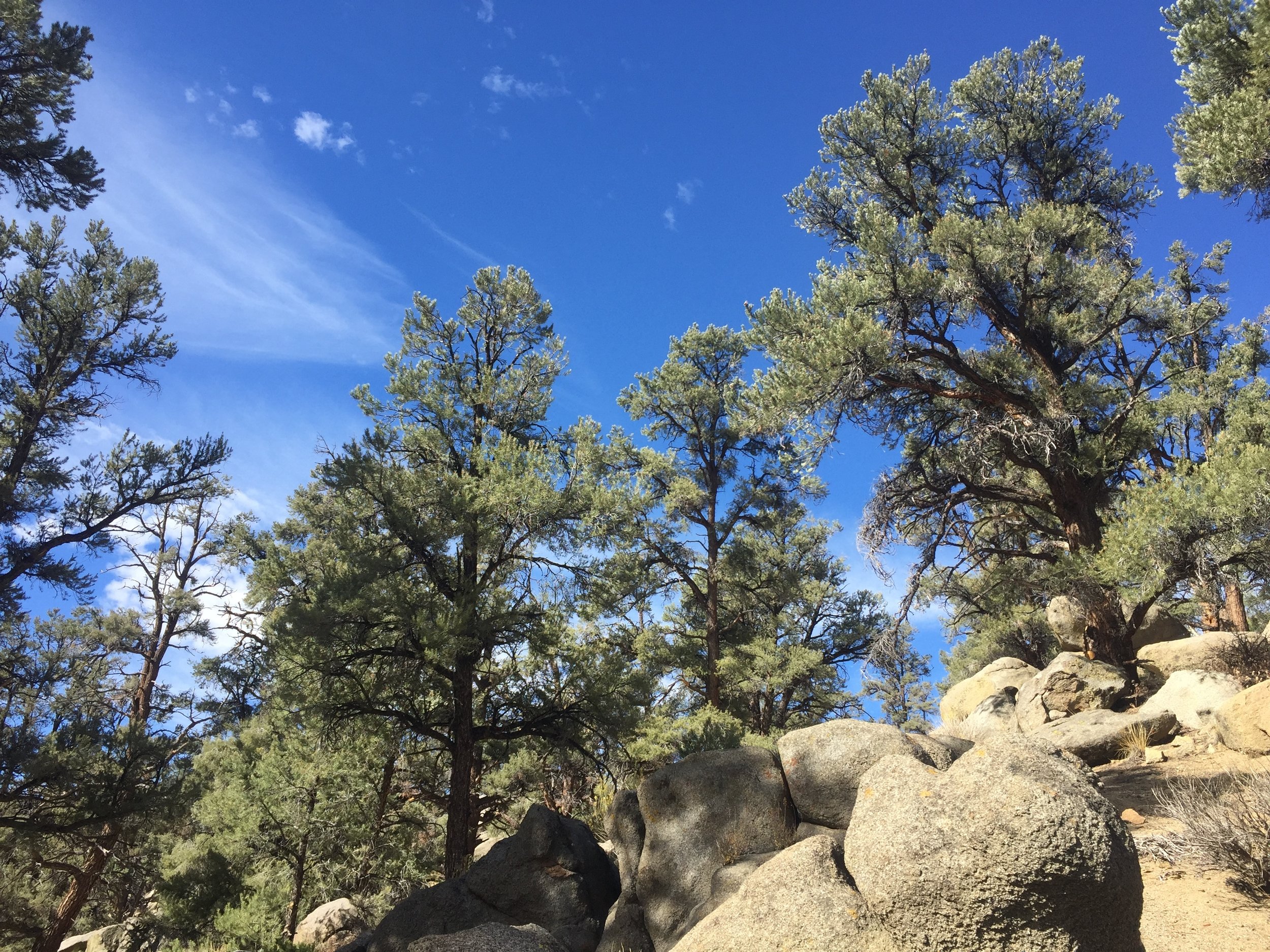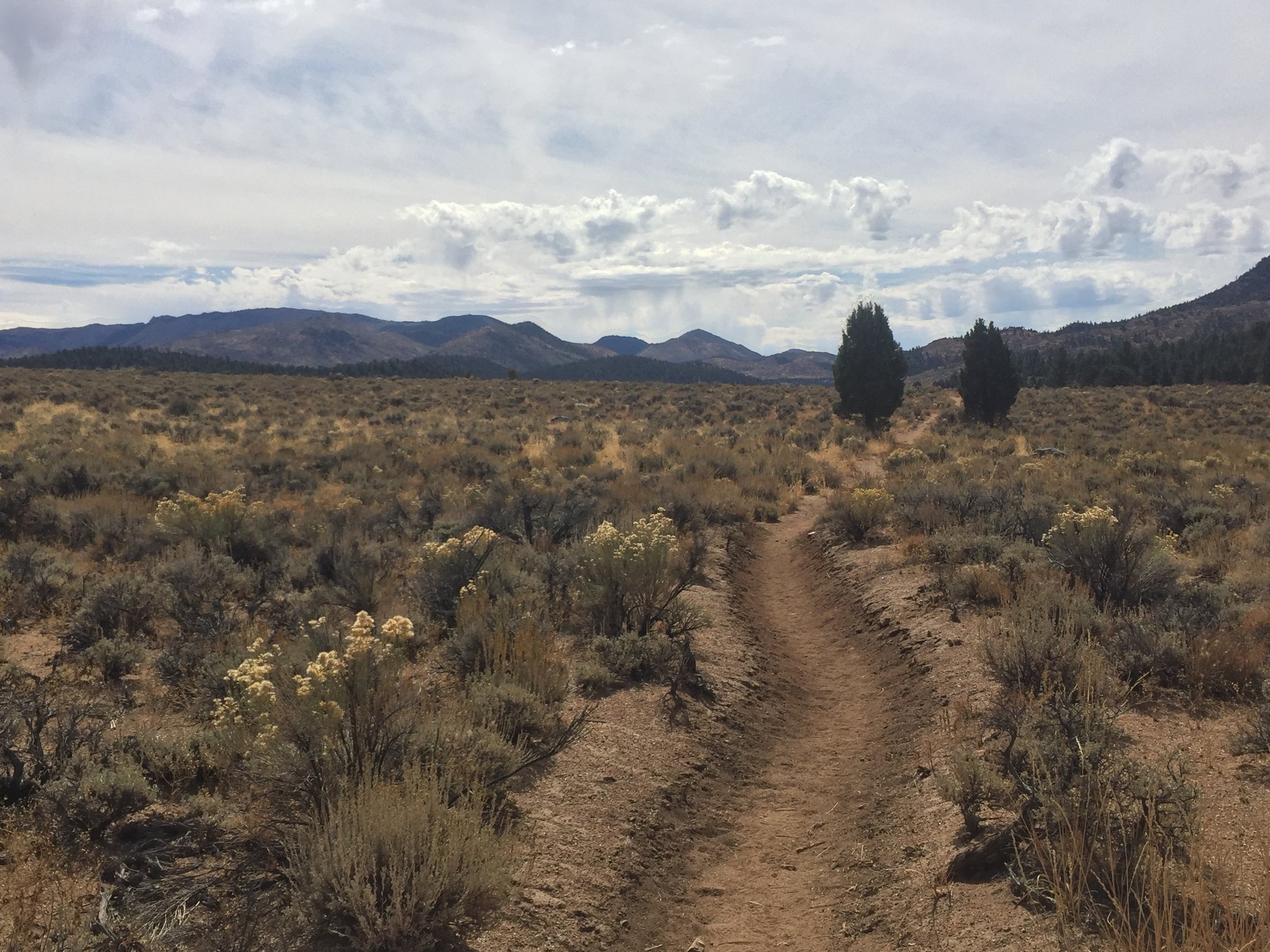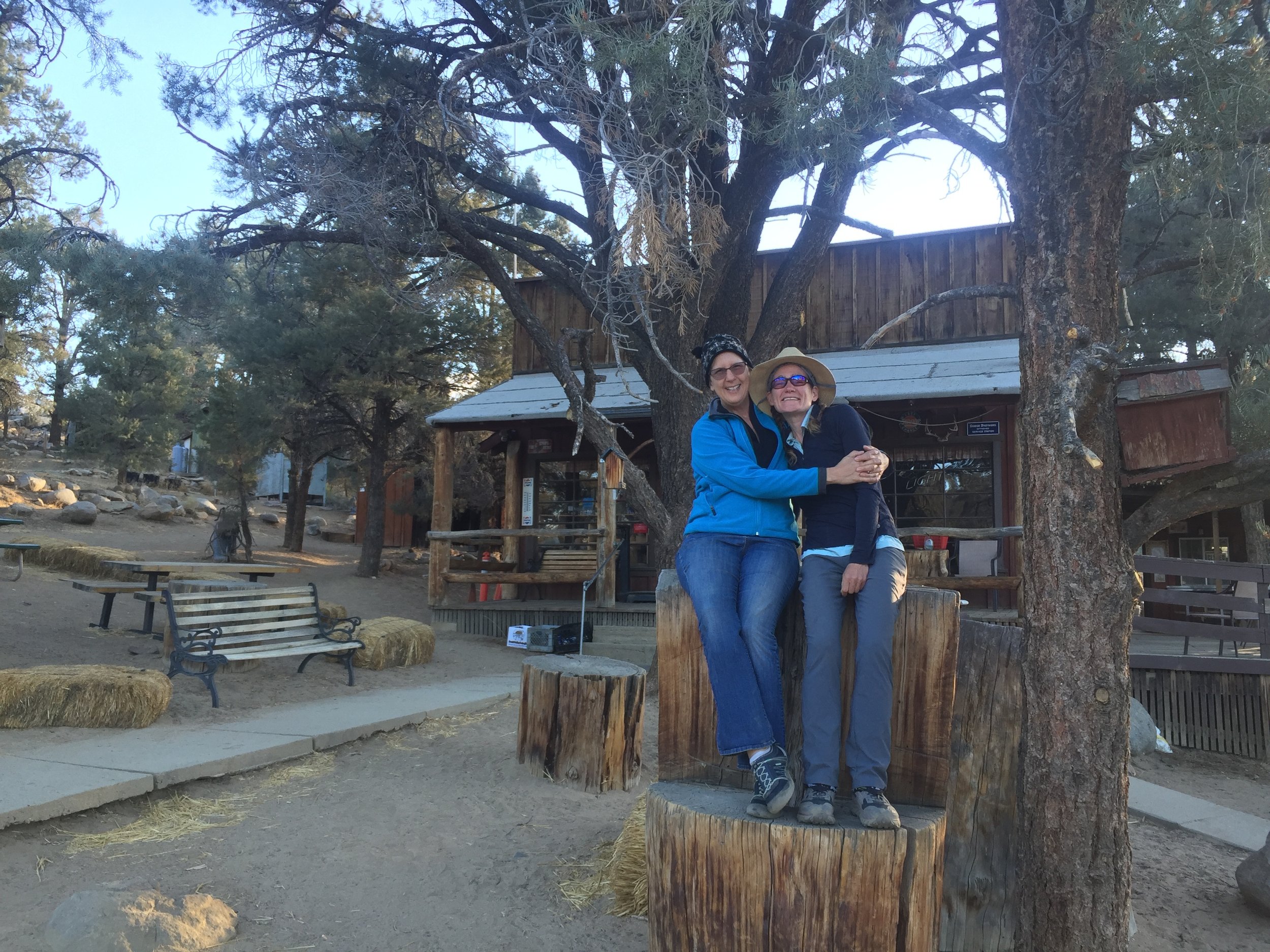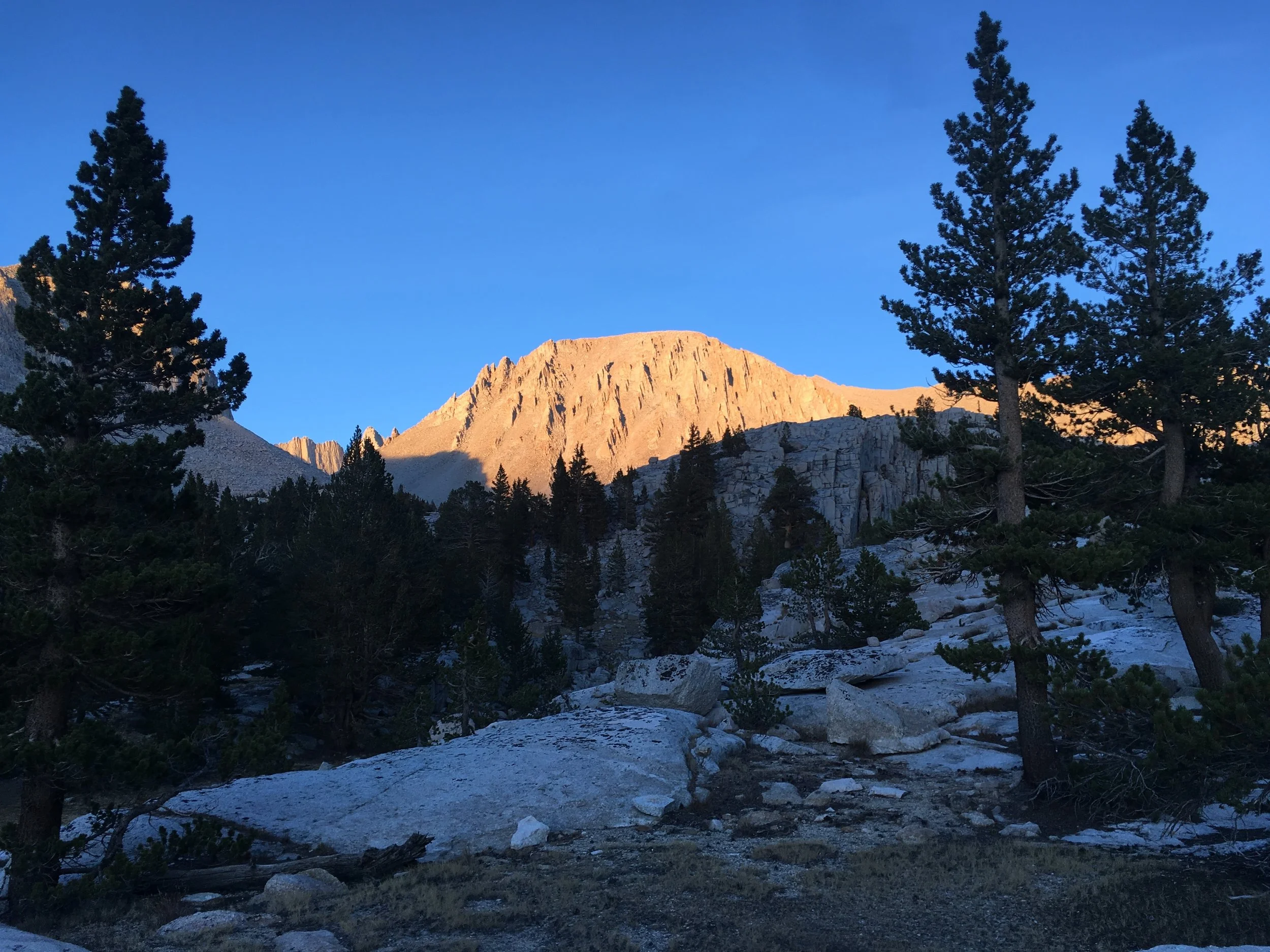Chicken Spring Lake to Kennedy Meadows General Store (48.6 PCT miles + 0.5 Bonus Miles)
Slope of Foxtail pines in the southern Sierra
This final stretch of the southern Sierra Nevada marked a transition in more ways than one. We are leaving the high country for good, entering the much drier terrain of the southern CA mountains and desert, embarking on a huge stretch of trail we have never visited, and starting the final section of our thru-hike. While we built some extra time into our itinerary to enjoy the heart of the Sierra with shorter-mileage days (and account for potential foul weather), leaving these mountains also means a return to our usual thru-hiker schedule. We feel the weather changing as the year goes on, and the end of summer is a distant memory that we passed on the trail many weeks back. Even as we come down out of the high mountains, it is clear that we are hiking steadily into the fall.
Chicken Spring Lake is the last we'll see in the Sierra Nevada
One of many high meadows as we head towards the southern reaches of the Sierra Nevada
We didn't expect to find this terrain so far south
Leaving Chicken Spring Lake, we expected to see the last of our Foxtail pines and granite. It turned out to be a longer and more beautiful transition out of the Sierra Nevada than advertised by other hikers. The trail stayed around 10,000' for much of the afternoon as we dropped to Cottonwood Pass, traversed around Trail Peak, and crossed the saddles of both Trail Pass and Mulkey Pass. Foxtails did remain the dominant conifer on these forested slopes though they now intermingled with nearly as many Lodgepole pines, and there was less sand and exposed granite with more organic soil and more undergrowth along the trail. We were no longer surrounded by high peaks in every direction though back to the north could still see the craggy and treeless mountaintops of southern Sequoia NP. Instead, we had long views to more gentle and tree-covered slopes across wide expanses of yellow meadows on the valley floors a thousand feet or so down below. Although the maps show streams and ponds in many of these meadows, they all appeared dry from our vantage point with no evidence of actual water or even swaths of green plants that would suggest wet ground. This lack of water is a big change from the past several weeks, and is something we will need to get used to as we enter dry southern CA. The outlet of Chicken Spring Lake had been bone-dry (and looked as if it hadn't had water all season), though the lake itself was fine. The next on-trail water source was only 4 miles later at Poison Meadow Spring, a shallow trickle of clear water across the trail that ran into a willow-choked meadow. In the heart of the Sierra Nevada, we wouldn't have given this difficult-to-collect flow a second glance as a water source and in fact we passed it by. I imagine that within only a few days we will look back and remember how fresh and clean this water looked, and wish for something so nice. There was an off-trail spring a few miles later in Dutch Meadow that was reportedly flowing but we continued on to Diaz Creek, almost 10 miles from the lake and our destination for the night as it was the only water source with camping options nearby and just the right distance for our day. Trail guides list this creek as a "reliable source even in dry years" and recent hikers reported flowing water, a good source to fill up in an otherwise dry section. The creek itself is 1/10 of a mile off-trail, and we arrived just at dusk. What we found was a wide and deep river channel through the dry meadow but only a narrow and lazy flow of shallow water along the bottom, choked by grasses and surrounded by cow pies. There were sticks on the ground arranged in an arrow and spelling out "water," and Macro headed in that direction to find a reasonably clear section of flowing water that was about 4" deep that he could collect from, but it was a wake-up call to us both that this was now considered a "good" water source. We definitely have to reset our expectations as we head further south.
Hiking across the high plateau approaching Diaz Creek
The terrain between Dutch Meadow and Diaz Creek became more sparse and desert-like. The Foxtail pines persisted but were spread much further apart, grew from white sandy soil, and were more likely to be stunted and contorted like their close cousins the Bristlecone pines. It was fitting, then, that we even caught a few glimpses of the White Mountains to the east as that dry range across the Owens Valley is one of few places on earth that the Bristlecone pines grow. Along with these sparse and scenic pines there were patches of sage, gnarled remains of old downed trees, and tiny high desert wildflower plants as the trail meandered past mounds of exposed rock on the wide plateau above what we would soon discover to be Diaz "Creek". As the sun went down the evening light was spectacular on the wide spaces, pale earth, and dramatic shapes of this high desert terrain. The sky towards the east became many shades of pink and purple while the trees and rocks around us took on an otherworldly glow. It felt like we were walking through some hybrid of a Georgia O'Keefe painting and an Ansel Adams photograph. We would have loved to linger until dark, but instead hurried to reach our campsite and alleged water source. In retrospect, our little spot at Diaz Creek was beautiful. It sat just across the creek from a hill covered in rounded boulders and desert brush that became silhouetted by the moonlight and made a great backdrop for the Big Dipper and all of the stars. In that moment of Day 95 as we were setting up the tent and making dinner, we were more focused on the fact that it wasn't terribly flat, it was surrounded by dried cow pies, and the water situation was suboptimal at best. By the next morning, we had recovered from our disappointment an did appreciate our surroundings once more before hitting the trail (with all containers full of clear, treated water). The night had been plenty cold, and we started hiking in layers as per usual.
A glimpse of the Owens Valley from the Golden "Trout" Wilderness, complete with golden Foxtails
Flowers growing from rocks add color in this high arid terrain
The terrain gets more desert-like as we lose elevation from the Owens Valley overlook
Heading south from Diaz Creek, we climbed immediately and meandered along high ridges through open forest of Foxtail pines. The terrain remained dry and there were many outcroppings of rounded granite, often pink in color. The sky was clear and brilliant blue, and as the sunlight hit us we started removing layers of clothing. We joked that while this was the Golden Trout Wilderness, we hadn't passed nearby a single water source that would support trout of any sort since Chicken Spring Lake, and today would be another 25 mile stretch between on-trail water sources. On the other hand, there were plenty of Foxtail pines and in the brilliant sunshine they often took on a golden tone. We decided that a much more appropriate name would be the Golden Foxtail Wilderness, and continued to enjoy the trees that were the new namesake of this area all day. Near the top of our morning's climb we found ourselves on an open ridge surrounded by tall stacks of rounded rock with deep cracks. Around every corner were clear views to the Owens Valley thousands of feet below and the White Mountains beyond. We lollygagged there a bit to take in the contrast, but had a long day planned and soon continued on to drop to our lowest elevation in days, just below 9000' at Death Canyon Creek. On the way down we transitioned from Foxtails alone to Foxtails with Lodgepoles, then with Jeffreys, then with Western juniper, but were surprised to see the Foxtail pines persisting through all of these ecosystems. It once again felt quite desert-like with sage, rabbitbrush, greasewood, mountain mahogany, and plenty of pale sand and rounded rocks. As we left the exposed ridge and dropped into the valley the temperature also increased and I was actually hot for the first time in weeks. Fortunately, there was a bit of a breeze and this kept it tolerable. I realized that this was another transition that would have to be made. Although the nights will still get cold, the days are bound to be much warmer in southern CA than we have been used to in the high country. It was no surprise to us that Death Canyon Creek was dry, and we weren't in need of water so we didn't investigate the nearby spring 2/10 of a mile off trail that was reported to be running and instead continued on towards our goal of the South Fork Kern River.
Mountain mahogany and manzanita in the lower reaches of the Golden Trout Wilderness
View north from the shoulder of Olancha Peak
We're really out of the mountains now. Headed towards the South Fork of the Kern River in golden hour light.
We stayed on the valley floor past Gomez Meadow and a few seasonal creeks (one muddy & fetid puddles, one bone dry), then climbed over the shoulder of Olancha Peak. This mountain had been prominent to the south since Cottonwood Pass, and provided the last reason to get over 10,000' in the Sierra (and likely for the remainder of the PCT). The day was quite warm by now and we started our climb by making a long ascending traverse across sage-covered slopes, once again thankful for a light breeze and our wide-brimmed hats. It struck us both that the terrain around us had clearly transitioned to that of the foothills as we were exiting this mountain range, and yet the trail was making a steady climb up the tallest thing around. It felt like a last hurrah of sorts, and as we rounded a corner and entered one last forest of Foxtail pines growing among white granite rock we both slowed our pace to appreciate what would probably be the last example of this ecosystem. Sure enough, we soon crested the shoulder and started a long descent out of these mountains altogether. The remainder of this afternoon on Day 96 took us across dusty and sage-covered slopes, through forests of Jeffrey Pine, across the dry creekbed of Cow Creek multiple times, and finally to the rolling high desert sage-covered "meadows" surrounding the Kern River. We could see the glimmer of water on the surface of the river from way up above, and recent hikers had reported 4-6" depth and good flow, so we were hoping not to be disappointed. We meandered through the sagebrush for the final mile, unable to see the river and wondering what we would find. As we approached the arching steel bridge over the channel, dozens of swallows flew by and it seemed to be a good omen. There was a swath of green grass on either side of the river and sure enough, there was water and it was flowing. Make no mistake, this is Tulare County which is better known for its cattle industry than its pristine waterways. The river was filled with slime, had foam in the eddys, had marshy grass-choked edges with plenty of cow pies, and 6" would have been a generous estimation of its average depth. But there were surprisingly large trout in the deepest areas, the water was indeed flowing well, and we found a few rocks along the shore that provided places to collect drinking water and rinse ourselves off in the clear-ish water. With our re-set expectations, the South Fork of the Kern River looked like heaven on this evening. We found a sweet spot in the trees just above the bridge, not too far from where Just Mike was setting up his own tent. This SOBO that we met a few nights ago at Crabtree Meadow is the only other person we've seen today. I suspect that as we head into the long waterless stretches of southern CA late in the year, we'll once again get used to having the trail nearly to ourselves. It was the first pleasant night we've had for several weeks, and we sat outside our tent eating dinner without even wearing our down jackets.
By the Numbers- Our campsite above the South Fork of the Kern River, at just below 8000', is the lowest elevation we have been at since north of Sonora Pass nearly 2 weeks ago. Even so, it is still nearly 500' higher than the highest point the PCT reaches through all of Oregon and Washington.
Headed south the morning of Day 97 from the first crossing of the Kern River
Crossing Crag "Creek" with no evidence of water
Pinyon Pines in the South Sierra Wilderness
We got up early on Day 97 to find the temperature well below freezing. The down jackets quickly came out and we packed up camp with numb fingers and toes, as has become our custom. We leapfrogged through the morning with Just Mike and got to know him a little better. He is the oldest thru-hiker we've met, and it was fun to hear how his experiences along the trail have differed from ours. We are now in the South Sierra Wilderness and while it no longer feels like the Sierra Nevada we know, the terrain is certainly beautiful. We enjoyed high thin clouds as we walked first over low, rounded hills of sage and Jeffrey Pine then traversed along steeper slopes of bright yellow, orange, and green desert plants contrasting against the bare and charred tree skeletons from a previous fire. By 10am we were ready to transition from multiple warm layers to the lightest clothing we are carrying, with sun hats and sun gloves for protection in this shade-less terrain. It seems that our new normal may be freezing nights and hot days, but fortunately we are well-versed in costume changes. We crossed Crag Creek (bone dry, just a ravine of willows and green grass) and made one final transition as we climbed onto slopes suddenly covered in Pinyon pine. This tree is unique in that it is a single-needled pine, and its grey-green needles and dark bark made a perfect visual contrast against the pale blue sky filled with thin high clouds. The Pinyon pine is found all across the Great Basin, and apparently also in the southernmost foothills of the Sierra. It is the source of edible pine nuts, and walking through these trees sparked memories of hunting for pine nuts with my great-aunt and uncle as a kid. I remember putting the cones into burlap bags, and Macro reminded me of a recent backpacking trip we took in Nevada's Great Basin NP. Reading the fine print at the visitor's center there he learned that there is a personal daily limit on pine nut/pinyon pine cone collection, and it is measured in number of gunny sacks! Apparently that is the container of choice for wild pine nuts. We crossed the South Fork of the Kern River once more, and this time its water looked clear and tumbled over large rounded rocks in a channel surrounded by Pinion pine, greasewood, and other native species. It seemed more fitting of its designation as a "wild and scenic" waterway, and it would have been hard to believe this was the very same river we camped next to last night.
A few miles from Kennedy Meadows we are officially out of the Sierra
The last few miles into Kennedy Meadows, clouds building to the south
The clouds continued to build as we hiked the final miles into the small high-desert resort community of Kennedy Meadows. We could see rain coming from many, but it was the type that never reaches the earth. It was visually dramatic, but did nothing to add to the dry terrain. We left the South Sierra Wilderness, passed through a small and deserted campground, and crossed several ATV/jeep tracks in the sandy sage-covered valley floor. Once we reached the paved road to Kennedy Meadows, we left the PCT and walked the final distance to the General Store together with Just Mike. The 3 of us were the only hikers there, and we all enjoyed ice cream bars and availed ourselves of the shower and laundry facilities. The shower was one of the most basic on the trail, but at $3 including towel, soap, shampoo, AND conditioner and without a timer it felt like heaven. I wasn't joking when I told the friendly and low-key guy behind the counter that it was the best $3 I've spent in a month. The washing machine was slow but worked as well as you might expect on a pile of dirty hiker laundry. There was no dryer but our clothes dried quickly on the line behind the store with the combination of desert air and afternoon wind. We picked up packages from friends, including a generous donation to the hiker box from Sue (some contents have already been claimed & appreciated!). SOBOs Wrong Turn and Eastwood came in, having summited Mt. Whitney the day after us and camped about 5 miles north of us last night. We gave them the lowdown on the place, including no cell service or WiFi, which meant we couldn't do much other than hang out. Fortunately, the store has a large deck and they didn't seem to mind us taking over their outdoor tables.
Happy hikers at KMS: Huckleberry, Macro, Eastwood, Wrong Turn, Just Mike (PC- Cynthia)
Cynthia & Huckleberry at KMS General Store
Right about then Cynthia drove up and of course arrived with enough food for a small army. All 5 SOBOs sat around a picnic table at KMS enjoying her famous vegetarian lasagne, a fresh salad of greens and Brussels sprouts, crackers, cheese, hummus, cucumbers, and a berry pie. We were not surprised by her generosity and cooking talent, but the other 3 were blown away and couldn't believe their great luck in happening onto this feast. We all discussed our plans for the next stretch of trail and particularly the water situation. Eastwood shared a printout of a recent water report from Bishop since none of us could download it here and hadn't thought to plan ahead. The others retired to their tents behind the store while we continued to catch up with Cynthia over the sorting of our resupply, and Macro adjusting his anticipated replacement backpack. We were surprised to learn from the maps that Agua Dulce, our next planned stop, is nearly 250 miles away. Somehow our itinerary listed it as a much shorter distance and while we had sufficient food between this resupply and the last, we had no desire to carry 9-10 days worth of food in our packs, especially with the weight of the water we'll certainly need in these dry stretches. After looking at our options, we decided to split the carry and make an intermediate stop in the town of Tehachapi about halfway between here and Agua Dulce. It would be cutting it close to try to mail a package from here, but Cynthia kindly offered to hand-deliver the box of second-half food & supplies to Tehachapi before she heads back home tomorrow. I'm sure we could get a thru-hike done without friends and family, but it wouldn't be nearly as enjoyable and would certainly be much more difficult. We have so much appreciation for Cynthia and every single person that has contributed to this amazing journey. It seems incredible, but tomorrow we head south from Kennedy Meadows and officially start the final stretch of our PCT hike as we enter the Southern California section.
Sitting atop Glen Pass, looking at the stormclouds we'll be racing to Kearsarge
Fun Facts- There were many spectacular days through the Sierra Nevada, so it was difficult to pick a favorite. But we both agreed on Day 90, when we went over incredibly beautiful Glen Pass then raced the snowstorm to Kearsarge Pass and by some serendipity found a trail angel right there in the Onion Valley trailhead parking lot who would drive us all the way to Bishop. Our favorite trail dinner was vegetarian paella with fava beans, artichoke hearts, and fennel which we initially cooked for a dinner party with friends, and dehydrated the leftovers and enjoyed on Day 87 in the upper reaches of Palisade Canyon. Our favorite campsite was on Night 86 at Evolution Lake, where we thought we had the entire basin to ourselves and were treated to classic Sierra evening light on the surrounding peaks.
By The Numbers-
We left Hwy 49/Sierra City late in the day on Day 70, and hiked into Kennedy Meadows South early afternoon on Day 97, taking just shy of 4 weeks to complete the Sierra Nevada section of the PCT.
We covered 493 PCT & alt route miles and 35 bonus miles during this stretch passing through 10 different wilderness areas, 3 national parks, and one national monument.
We took our third zero of the trip in Bishop on Day 91, and excluding that day hiked a median daily distance of 20.2 miles.
Our longest-mileage day was on Day 76, when we hiked 28.6 miles from Echo Lake to camp at Lily Pad Lake in the Mokulumne Wilderness, also the only place we slept tentless.
Our shortest hiking day was Day 72, when we neroed into I-80/Truckee with 9.9 miles.
Our highest-elevation campsite was at 12,254' on Night 92 below Forester Pass, while our lowest-elevation campsite was at 5273' on Night 70 along Milton Creek not too far south of Sierra City.
We slept a total of 9 nights between 7000' and 9000' in elevation, 7 nights over 10,000', and the remainder between 9000' and 10,000'.
With the weather getting colder we now pitch the tent with the rainfly every night, as it offers both warmth and some protection from the wind. We slept without it 7 nights in this section, but not once since a Night 84.
- Huckleberry




















